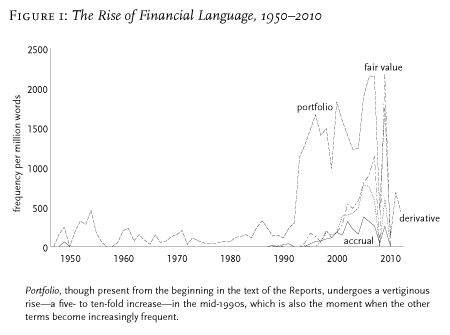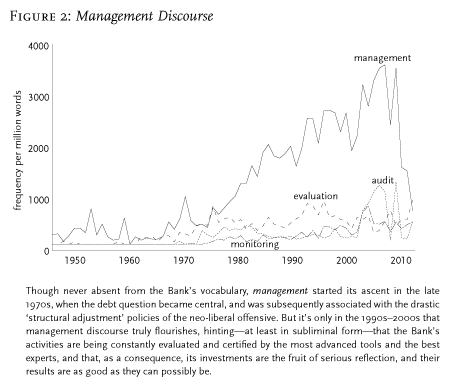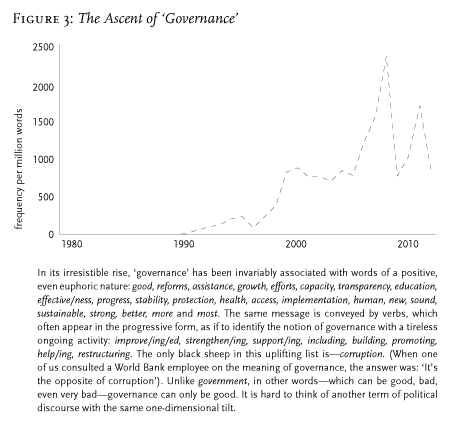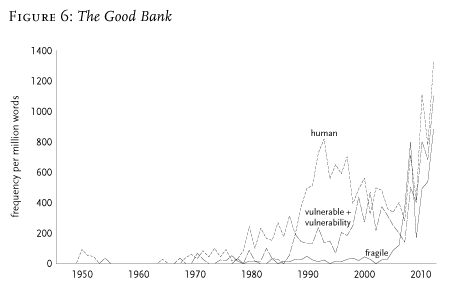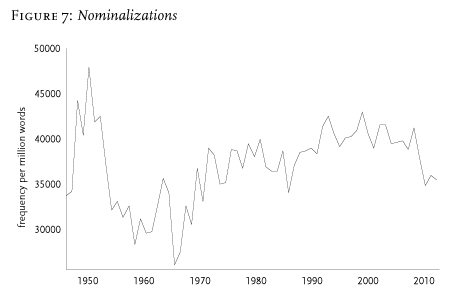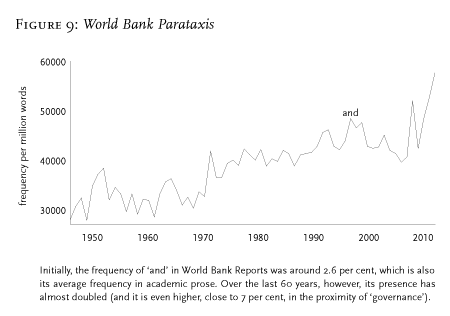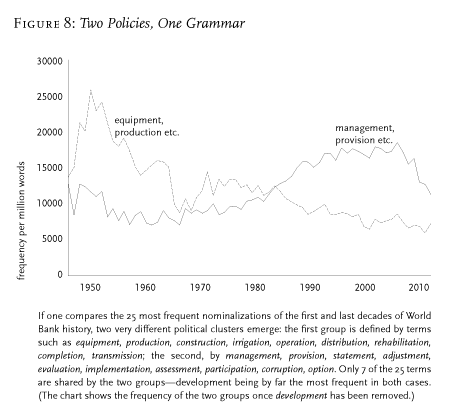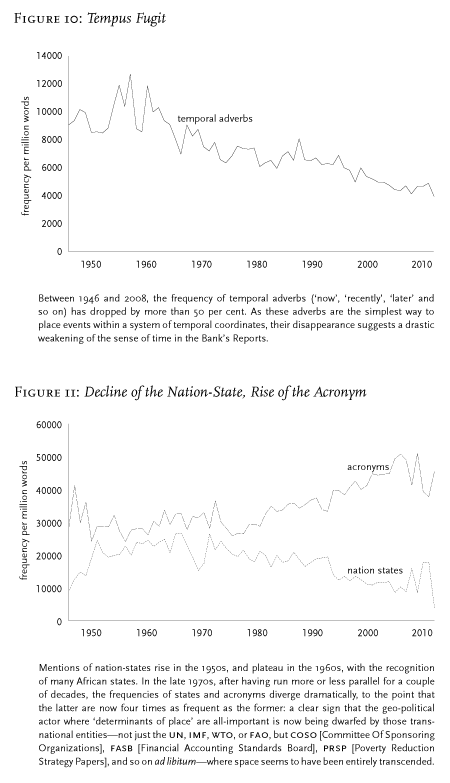The Language of World Bank Reports
What can quantitative linguistic analysis tell us about the operations and outlook of the international financial institutions? At first glance, the words most frequently used in the World Bank’s Annual Reports give an impression of unbroken continuity.footnote1 Seven are near the top at any given time: three nouns—bank, loan/s,development—and four adjectives: fiscal, economic, financial, private. This septet is joined by a handful of other nouns: ibrd, countries, investment/s, interest, programme/s, project/s, assistance, and—though initially less frequent—lending, growth, cost, debt, trade, prices. There is also a second, more colourless set of adjectives—other, new, such, net, first, more, general—plus agricultural, partly replaced from the 1990s by rural.footnote2 The message is clear: the World Bank lends money for the purpose of stimulating development, notably in the rural South, and is therefore involved with loans, investments and debts. It works through programmes and projects, and considers trade a key resource for economic growth. Being concerned with development, the Bank deals with all sorts of economic, financial and fiscal matters, and is in touch with private business. All quite simple, and perfectly straightforward.
And yet, behind this façade of uniformity, a major metamorphosis has taken place. Here is how the Bank’s Report described the world in 1958:
The Congo’s present transport system is geared mainly to the export trade, and is based on river navigation and on railroads which lead from river ports into regions producing minerals and agricultural commodities. Most of the roads radiate short distances from cities, providing farm-to-market communications. In recent years road traffic has increased rapidly with the growth of the internal market and the improvement of farming methods.
And here is the Report from half a century later, in 2008:
Levelling the playing field on global issues
Countries in the region are emerging as key players on issues of global concern, and the Bank’s role has been to support their efforts by partnering through innovative platforms for an enlightened dialogue and action on the ground, as well as by supporting South–South cooperation.
It’s almost another language, in both semantics and grammar. The key discontinuity, as we shall see, falls mostly between the first three decades and the last two, the turn of the 1990s, when the style of the Reports becomes much more codified, self-referential and detached from everyday language. It is this Bankspeak that will be the protagonist of the pages that follow.
i. semantic transformations
Nouns are at the centre of World Bank Reports. During the first two decades, 1950–70, the most frequent among them can be grouped in two main clusters. The first, obviously enough, encompasses the economic activities of the Bank: loan/s, development, power (in the sense of electricity), programme, projects, investment, equipment, production, construction, plant; further down the list are companies, facilities, industry, machineries, followed by a string of concrete terms like port, road, steel, irrigation, kWh, river, highway, railway—and then timber, pulp, coal, iron, steam, steel, locomotives, diesel, freight, dams, bridges, cement, chemical, acres, hectares, drainage, crop, cattle, livestock. All quite appropriate for a bank which offers loans and investments (the only explicitly financial terms in this long list) to promote a variety of infrastructural development projects.footnote3
The second noun cluster is much smaller (just a dozen words), and describes how the Bank actually operates. Confronted with existing demands, its experts analyse numbers, but they also pay visits, realize surveys and conduct missions in the field; the classic ingredients of a scientific approach to a complex situation, which requires the active presence of experts to collect and elaborate the data. Afterwards, the Bank proceeds to advise countries, suggest solutions, assist local governments and allocate its loans. Rhetorically, investment programmes are defined by the needs of the local economy, according to the basic idea that investment in infrastructure will lead to economic development and social well-being. At the end of every cycle, the Bank specifies what has been lent, spent, paid and sold, and describes the equipment—dams, factory, irrigation systems—that has been put into operation. A clear link is established between empirical knowledge, money flows and industrial constructions: knowledge is associated with physical presence in situ, and with calculations conducted in the Bank’s headquarters; money flows involve the negotiation of loans and investments with individual states; and the construction of ports, energy plants, etc., is the result of the whole process. In this eminently temporal sequence, a strong sense of causality links expertise, loans, investments, and material realizations.
Apart from the Bank, three types of social actors appear in the texts during this period: states and governments; companies, banks and industry; engineers, technicians and experts. This social ontology confirms the standard account of post-war reconstruction as industrial, Fordist and Keynesian. The protagonists of economic growth are businessmen and bankers, working with industrial companies, economists and engineers to implement projects within a national framework presided over by a state. What has to be managed is the economy—‘the self-contained structure or totality of relations of production, distribution and consumption of goods and services within a given geographical space’, as Timothy Mitchell has put it—whose results are optimized by a ‘modern apparatus of calculation and government’.footnote4 With the help of the Bank, governments adjust investments and financial parameters so as to modernize countries: that is to say, to industrialize them, beginning with basic material infrastructures. It’s the legacy of Walt Whitman Rostow, author of The Stages of Economic Growth: A Non-Communist Manifesto (1960) and a key policy advisor to American administrations from Eisenhower to Johnson. Development proceeds in stages, and its ‘take-off’ is triggered by the production of raw materials, the creation of infrastructures and an agricultural sector oriented towards exports.
Let us pause briefly on a specific passage from 1969. It appears in the general introduction of the Report, in a section on agricultural loans, and its language is so simple, it seems almost featureless:
Many developing countries need to transform their agriculture . . . the Bank Group continues to encourage these trends through its lending for general agricultural development, which totalled $72.2 million in the 1969 financial year. Diversification into new crops which provide a source of cash income, or improved production of existing ones, was encouraged by loans or credits to support traditional coffee production in Burundi at its normal level, palm oil development in Cameroon, Dahomey, the Ivory Coast and Papua, afforestation in Zambia, and mechanization of sorghum, sesame and cotton farming in the Sudan . . . A $13 million Bank loan to India will finance the production of seeds of new high-yielding varieties of foodgrains; at full development the project will produce enough seeds to plant seven million acres with the new varieties. This is the first loan the Bank has made for seed production.
Aside from the initial injunction that agriculture ‘needs’ to change, the dominant note is one of factual precision: amounts, countries, materials, productive activities, objectives of the investments. Nouns are frequent and adjectives rare: things are being described, not advertised. Verbs specify the type of action involved: to encourage, provide, improve, support, diversify, produce, finance. The present tense reports what is happening now (the bank continues to encourage); when a project has not yet been launched the tense shifts to the future (the credit will finance seed production), while the past accounts for what has been completed (diversification was encouraged, lending totalled $72.2 million). Clearly demarcating past accomplishments, current actions, necessary policies and future projects, this temporal structure reinforces the sense of factuality of the early Reports.
Finance, management, governance
Let’s now shift to the most recent decades. Three new semantic clusters characterize the language of the Bank from the early 1990s on. The first—and most important—has to do with finance: here, alongside a few predictable adjectives (financial, fiscal, economic) and nouns (loans, investment, growth, interest, lending, debt), we find a landslide of fair value, portfolio, derivative, accrual, guarantees, losses, accounting, assets; a little further down the list, equity, hedging, liquidity, liabilities, creditworthiness, default, swaps, clients, deficit, replenishment, repurchase, cash. In terms of frequency and semantic density, this cluster can only be compared to the material infrastructures of the 1950s–60s; now, however, work in agriculture and industry has been replaced by an overwhelming predominance of financial activities. Figure 1 is a good illustration of the Bank’s new priorities.
The second cluster has to do with management—a noun that, in absolute terms, is the second most frequent of the last decade (lower than loans, but higher than risk and investment!). In the world of ‘management’, people have goals and agendas; faced with opportunities, challenges and critical situations, they elaborate strategies. To appreciate the novelty, let’s recall that, in the 1950s–60s, issues were studied by experts who surveyed and conducted missions, published reports, assisted, advised and suggested programmes. With the advent of management, the centre of gravity shifts towards focusing, strengthening and implementing; one must monitor, control, audit, rate (Figure 2); ensure that everything is done properly while also helping people to learn from mistakes. The many tools at the manager’s disposal (indicators, instruments, knowledge, expertise, research) enhance effectiveness, efficiency, performance, competitiveness and—it goes without saying—promote innovation.
To better understand this ‘management discourse’, as Boltanski and Chiapello have called it in The New Spirit of Capitalism, we decided to run a little experiment. We took two related expressions—‘poverty’ and ‘poverty reduction’—and followed their occurrences from 1990 to 2010, comparing their respective ‘collocates’: that is to say, the words that tend to occur most often in their immediate proximity. Near poverty, the dominant note was one of straightforward economic realism: bank was the most frequent word; million, the second; and then total, cost, population, incomes, services, problems, work, production, employment, resources, food, health, agriculture. Which makes perfect sense, because these are indeed the terms that define the perimeter of poverty. What doesn’t make sense, on the other hand, is that only four of them—services, work, resources, health—should reappear near poverty reduction. Poverty is the problem, poverty reduction the policy that should address it; they should have plenty of core terms in common. And instead, the most characteristic collocates of poverty reduction are not cost, population, income—let alone production or employment—but strategies, programmes, policies, focus, key, management, report, goals, approach, projects, framework, priorities, papers. ‘Management discourse’, in all its glory. Never mind employment and income: focus, key, approach, framework—these are the critical terms in reducing poverty. Policy turned into paperwork, with goals and priorities and papers inching their way through the department that—in the acronym-obsessed language of the Reports—is known as prem: Poverty Reduction and Economic Management.
The third semantic cluster of the last two decades comprises governance and moral behaviour.footnote5Governance, first of all: this shibboleth of World Bank language first showed up in a crowded sentence of the 1990 Report—‘the strength of managerial institutions and personnel and the quality of governance also determine how well reform policies are actually put into practice’—and then increased its presence to the point that it is now as frequent as ‘food’, occurring ten times more often than ‘law’ and a hundred times more than ‘politics’ (Figure 3).footnote6
Three adjectives have been shadowing governance in its irresistible progress: global, environmental, civil. They are complemented by dialogue,stakeholders, collaboration, partnership, communities, indigenous people, accountability—plus climate, nature, natural, forest, pollution. Even health and education have ended up near the orbit of governance (Figures 4 and 5).
Finally, the semantic cluster of governance includes a series of terms which express a sense of compassion, generosity, rectitude or empathy with the world’s problems. Virtually absent in previous decades, these ethical claims emerge in the mid-1980s, and become second nature by the early 1990s, when responsible,responsibility, effort, commitment, involvement, sharing, care are suddenly everywhere.footnote7 Nor is the Bank blind to fragile and vulnerable people, to poverty (revitalized in 1995 by the new Director General James Wolfensohn), and to all that is human (Figure 6). This cluster also includes rights, law, justice and (anti-)corruption. People, behaviour and results are outstanding, significant, relevant, consistent, strong, good, better. Enhancing and promoting what is appropriate, equitable and sound: this is the Bank’s credo. The overall effect is one of dedication and commitment; the Bank’s sense of responsibility is as admirable as its efficiency.
Let us again pause on a specific passage to add some texture to our analysis. Here is the opening of the 2012 Report:
The World Bank is committed to achieving and communicating results.
In its ongoing dedication to overcoming poverty and creating opportunity for people in developing countries, the Bank is making progress both internally and in the field, and it continues to improve the way it serves its client countries.
A place full of ‘opportunities’ that the poor may seize in order to change their condition: this is how the Bank sees the world. Within this scenario, its activity consists in establishing the legal and cultural framework necessary for a variety of initiatives to flourish; still investment in infrastructures, in a sense—except that they’re no longer made of stone and steel. The Bank is dedicated and committed, thoughtful, invested in a better world. It is forward-looking, its dedication ongoing, constantly thinking about improving and serving the poor countries that are its . . . clients.
Clients? At first, the word is jarring: if dedication suggests a universe of moral justice, client refers to business, rational interests, and power relations. In deliberately linking them within a single sentence, though, the Bank suggests that the two are no longer in opposition: nowadays, business is as attentive to stakeholders as to shareholders; like civil society and the Bank itself, it is socially and environmentally responsible, and engaged in durable governance made of multiple partnerships. Ethics is at the heart of the business world, and of its contractual relationships.
Complexity and crisis
Having established the two contrasting paradigms of World Bank discourse, let us briefly sketch the process that led from the one to the other. A few adjustments aside, the intellectual framework that defined the Bank’s operations in the 50s and 60s remained fundamentally in place up to the late 1970s: irrigation, chemical inputs, the Green Revolution and the industrial–infrastructural synergy continue to be the key ingredients of economic take-off. But the belief in a linear approach is losing its force: as the 1960s come to a close, it becomes clear that, if building infrastructure is relatively simple, its reliable long-term operation is not: it requires specialists, qualified workers and the regular supply of key products like electricity—none of which can be taken for granted in the countries of the South. To make things worse, international exchanges seem to respect neither the Bank’s hopes, nor the theories of development à la Rostow. The prices of agricultural raw materials—crucial for the economies of the South—are far from stable and undergo major falls, from which recovery is difficult. The consequences of such instability can be dramatic: as prices drop, developing countries cannot afford to persevere on the virtuous path by which the export of raw materials finances the growth of infrastructure . . . and the repayment of foreign loans. Mindful of its investments, the Bank is worried.
The language of the Reports adapts to the changing environment; words like commodities, or improvements, raise the analysis to a higher level of abstraction than, say, hydroelectric plants and cement. And since leading the world by relying merely on material infrastructures no longer seems enough, other ‘factors’ are taken into account: the market, of course, but especially the ‘human factor’. On becoming the Bank’s president in 1967, Robert McNamara places lbj’s ‘war on poverty’ at the centre of its strategy. It’s the time of small-scale farms and cooperatives (faint echoes of decolonization and social unrest); of farmers (previously marginal to the Bank’s policy); of families (and soon of women). Education is now seen as indispensable in maintaining progress, along with school, primary, secondary, educational, training. It’s the time of the explosion of towns (and shantytowns); of rural emigration, and the deterioration of the urban (a ubiquitous adjective) way of life; whence a long list of new problems—housing, drainage,sewers.
In the second half of the 1970s, the oil crisis introduces new exogenous elements. Words like debt, borrowed and borrowing become increasingly frequent, along with those that refer to a country’s reliability (or lack thereof): cost/s, exports, co-financing. The discourse of reform—destined for unimaginable success—begins to take shape. And since debt is linked to the evolution of prices, these, too, become more visible in the Reports (in fact, it’s amazing how invisible they had previously been). The crisis reveals the World Bank as, indeed, a bank—and one that finds it difficult to recover its loans: a fact that may seem obvious, but that, until then, had been largely muted.
In response to all this, the causal chain linking loans and development, investments and economic progress, is lengthened to include families and education, small farmers and sewers. This is hardly an unfeasible adjustment, and even the logic behind the debt continues to appear reasonably simple: there are loans, faltering exports, problematic reimbursements—the inter-connections are clear, comprehensible. But the world as seen through the World Bank Reports is becoming less linear than it used to be; socio-economic dynamics are harder to disentangle, and there is a faint surprise in the face of events that aren’t following the expected course. At times, the surprise seems genuine; if this were so (but is it possible?) it would speak volumes about the delusions of development in the post-war period. As the policy of infrastructural growth becomes partially destabilized, a sense of indecision and even openness emerges—in sharp contrast with the previous decades, when everything was self-evident and almost automatic. But the openness will not last; at the end of the 1970s, the auto-pilot will be reinserted—this time, en route to ‘structural adjustment’.
Debts and restructuring
The Reports of the 1980s are dominated by the debts of the South, and by the structural adjustments that are the keyword of the decade. The semantics of crisis is omnipresent—deterioration, deficit, decline, indebted, issues, difficult—and defines the parameters that must be met before granting any country a new loan: balance of payments, current account, debt services. The hope of recovery, for its part, is heard far less often. It’s the ‘development philosophy’ of the times: liberal recipes that will ensure the only thing that matters, the return to growth. This means expanding trade, expanding the private sector, raising competitiveness; the rules of economic activity must be redefined (making it freer), and the role of the state reduced. It’s the moment of the liberalization of the public sector. People must learn to be efficient and cost-effective, care about performance, develop incentives. The Bank outlines the solutions, and demands that they be implemented, leaving little room for negotiation. Restructuring and rescheduling are the only way to reassure the creditors.
A few chronological details. In the years 1982–89, the main semantic cluster is still a melancholy one: slowdown, stagnation, degradation, depreciation, devaluation, fall/fell, exacerbated, severe. In the 1990s, there is a shift toward private sector, privatization, privatized, financial sector, creditworthiness, along with market-oriented activities and institution building, a code word for the liberalization/privatization of public institutions. The lexicon of global finance has not yet emerged, although that of nature, the environment and civil society is beginning to circulate. Meanwhile, management leaves its imprint on a series of verbs which express the harsh policies prescribed by the Bank: to address, target, accelerate, support, restructure, implement, improve, strengthen, aim, achieve . . .
Aside from individual words, it’s the nature of the Bank’s language that is changing: becoming more abstract, more distant from concrete social life; a technical code, detached from everyday communication and pared down to the economic factors crucial to the repayment of the debt. Solutions are disengaged from any specificity: they are the same for everybody, everywhere. Faced with the potentially devastating consequences of default, the Bank’s chief objective is no longer development, but, more simply, the rescue of private lenders (Harpagon: ‘My casket! My casket!’). The banker must be saved before the client: doubts have disappeared, and the Bank’s core beliefs are hammered home over and over again: the economy must be strengthened by making it leaner; the public sector must be restructured to create favourable conditions for private business and the market; the state must shrink and become more efficient. Such ‘solutions’ transcend the need to respond to the debt crisis: they aim at social transformation through the return to an uncompromising liberalism.
ii. grammatical patterns
So far, our findings have been rather straightforward: as the economic situation evolves, policy changes, and language too; yet the Bank itself remains the same. We will now shift our attention to aspects of language that change very little, and very slowly. A ‘bureaucratization’ of the Bank’s discourse, one could call it—except that it’s more than that: it’s a style that self-organizes around a few elements, then starts generating its own message. Let us try to explain, by returning to the two passages we quoted at the beginning of this essay. The one from 1958, on ‘the Congo’s present transport system’, was full of rivers, farms, markets, railroads, ports, minerals, cities . . . It couldn’t have been clearer. The second passage, from 2008, was different. Here it is again:
Levelling the playing field on global issues
Countries in the region are emerging as key players on issues of global concern, and the Bank’s role has been to support their efforts by partnering through innovative platforms for an enlightened dialogue and action on the ground, as well as by supporting South–South cooperation.
Issues, players, concern, efforts, platforms, dialogue, ground . . . ‘The whole tendency of modern prose is away from concreteness’, wrote Orwell in ‘Politics and the English Language’, and his words are as true today as they were in 1946. The Bank stresses the importance of what it’s saying—key, global, innovative, enlightened—but its words are hopelessly opaque. What is it really trying to say—or to hide?
‘A mass of Latin words falls upon the facts . . . ’
Opacity is hard to understand, so we will break it down into smaller units, beginning with its movement ‘away from concreteness’. In the passage from 2008, the terms action and cooperation belong to a class of words usually known as ‘nominalizations’, or ‘derived abstract nouns’; derived, in this case, from verbs: to ‘act’, to ‘cooperate’.footnote8 In English, such terms are recognizable by their typical ending in -tion, -sion and -ment (implementation, extension, development . . . ); so, we extracted from the Reports all the words with such an ending and hand-checked the top 600 (to eliminate ‘station’, ‘cement’, and the like). Figure 7 presents the results. According to corpus linguistics, in academic prose the average frequency of nominalizations derived from verbs is 1.3 per cent. In the World Bank Reports, the frequency is near 3 per cent from the start, with a higher peak around 1950, and it keeps growing, slowly but steadily, plateauing at 4 per cent between 1980 and 2005, and dropping slightly thereafter.
A class of words that is used two or three times more often than in comparable discourses.footnote9 Why? What do nominalizations do, that the Reports should use them with such insistence? They take ‘actions and processes’ and turn them into ‘abstract objects’, runs a standard linguistic definition:footnote10 you don’t support countries which are cooperating with each other; you support ‘South–South cooperation’. An abstraction, where temporality is abolished. ‘The provision of social services and country assessments and action plans which assist in the formulation of poverty reduction policies’, writes the Report for 1990—and the five nominalizations create a sort of simultaneity among a series of actions that are in fact quite distinct from each other. Providing social services (action one) which will assist (two) in formulating policies (three) to reduce poverty (four): doing this will take a very long time. But in the language of the Report, all these steps have contracted into a single policy, which seems to come into being all at once. It’s magic.
And then—the authors of Corpus Linguistics continue—in nominalizations, actions and processes are ‘separated from human participants’:footnote11 cooperation, not states which cooperate with each other. ‘Pollution, soil erosion, land degradation,deforestation and deterioration of the urban environment’, mourns another recent Report, and the absence of social actors is striking. All these ominous trends—and no one is responsible? ‘Prioritization’ enters the Reports as debt crisis looms; meaning, quite simply, that not all creditors would be treated equally: some would be reimbursed right away, others later; some in full, and others not. Of course, the criteria according to which X would be treated differently from Y had been decided by someone. But prioritization concealed that. Why X and not Y? Because of prioritization. In front of the word, one can no longer see—one can no longer even imagine—a concrete subject engaged in a decision. ‘Rendition’: an American secret agency kidnaps foreign citizens to hand them over to another secret service, in another country, that will torture them. In ‘rendition’, it’s all gone. It’s magic.footnote12
This recurrent transmutation of social forces into abstractions turns the World Bank Reports into strangely metaphysical documents, whose protagonists are often not economic agents, but principles—and principles of so universal a nature, it’s impossible to oppose them. Levelling the playing field on global issues: no one will ever object to these words (although, of course, no one will ever be able to say what they really mean, either). They are so general, these ideas, they’re usually in the singular: development, governance, management, cooperation. It’s the ‘singularization’ that Reinhart Koselleck discovered in late eighteenth-century thought: ‘histories’, which had ‘previously existed in the plural, as all sorts of histories which had occurred’, becoming ‘history in general’; the ‘progresses’ of the various technical and intellectual branches converging into a single ‘progress’, and so on.footnote13
For Koselleck, singularization was the result of the ‘growing complexity of economic, technological, social and political structures’, which forced social theory to increase the ‘degree of generality’ of its categories.footnote14 Which is true: singular abstract nouns allow us to synthesize and generalize, and are thus indispensable to the construction of knowledge. But World Bank Reports are not primarily about knowledge: they are about policy; and in policy, singularization suggests not a greater generality, but a stronger constraint. There is only one way to do things: one development path; one type of management; one form of cooperation. It’s hard to believe, but the verb todisagree never appears in the Reports; disagreement, twice in seventy years.footnote15 It’s the formula made famous by Margaret Thatcher: There Is No Alternative. And singularizations assert this, not with arguments, but with the unspoken ‘fact’ of a recurrent grammatical pattern. World Bank policies change, as we have seen, but singularization does not: each new policy is the only possible one (Figure 8).footnote16
The transition from semantic clusters to grammatical structures—from the first to the second part of this essay—entails, so to speak, a certain loss of momentum: compared to the dramatic trajectories of Figures 1–6, with their five- or ten-fold increases, the mild incline of Figure 7 is hardly impressive. But its slowness tells us something which is just as important: behind all the changes, the first element of an institutional ‘style’ had successfully crystallized. Nominalizations remained unusually frequent because they ‘worked’ in so many interconnected ways: they hid the subject of decisions, eliminated alternatives, endowed the chosen policy with a halo of high principle and prompt realization. Their abstraction was the perfect echo of a capital that was itself becoming more and more deterritorialized; their impossible ugliness—‘prioritization’: come on!—lent them a certain pedantic reliability; their ambiguity allowed for the endless small adjustments that keep the peace in the world order. And so, this mass of Latin words became a key ingredient of ‘how one talks about policy’. Specific semantic fields rise and fall with their referents; they are, one could almost say, the histoire événementielle of political language. Grammar is made of rules and repetition, and its politics is in step with longer cycles: structures, more than events. It defines, not a policy of the Bank, but the way in which every policy is put into words. It is the magic mirror in which the World Bank can gaze, and recognize itself as an institution.
And . . . and . . . and . . .
We briefly discussed the collocates of governance in the caption to Figure 3, but we didn’t mention that the biggest surprise came with the most frequent collocate of all: and. ‘And’? The most frequent word in English is ‘the’: everybody knows that. So, what is ‘and’ doing at the top of the list? Two passages from the 1999 Report may help to explain:
promote corporate governance and competition policies and reform and privatize state-owned enterprises and labour market/social protection reform
There is greater emphasis on quality, responsiveness, and partnerships; on knowledge-sharing and client orientation; and on poverty reduction
The first passage—a grammatico-political monstrosity—is a small present to our patient readers; the second, more guarded, is also more indicative of the rhetoric in question. Knowledge-sharing has really nothing to do with client orientation; poverty reduction, nothing to do with either. There is no reason they should appear together. But those ‘ands’ connect them just the same, despite the total absence of logic, and their paratactical crudity becomes almost a justification: we have so many important things to do, we can’t afford to be elegant; yes, we must take care of our clients (we are, remember, a bank); but we also care about knowledge and partnership and sharing and poverty!
‘Bankspeak’, we have written, echoing Orwell’s famous neologism; but there is one crucial difference between the lexicographers of 1984 and the Bank’s ghost writers. Whereas the former were fascinated by annihilation (‘It’s a beautiful thing, the destruction of words . . . every year fewer and fewer words, and the range of consciousness always a little smaller’), the latter have a childish delight in multiplying words, and most particularly nouns. The frequency of nouns in academic prose is usually just below 30 per cent; in World Bank Reports it has always been significantly higher, and has increased slowly and regularly over the years. It is the perfect rhetoric to bring the ‘world’ inside the ‘bank’: a ‘chaotic enumeration’ of disparate realities—to quote an expression coined by Leo Spitzer—that suggests an endlessly expanding universe, encouraging a sense of admiration and wonder rather than critical understanding.
The last passage we quoted—on ‘client orientation’ and ‘poverty reduction’—is a good example of another tic of World Bank discourse: using a noun to modify another noun. Here are some examples of these ‘adjunct nouns’, as they are usually called, from the 2012 Report:
the Bank’s operations effectiveness, including the quality and results orientation of its operations and knowledge activities, the performance of its lending portfolio, the mainstreaming of gender in its operational work, client feedback, and its use of country systems.
Our agenda has included gender equality, food security, climate change and biodiversity, infrastructure investment, disaster prevention, financial innovation, and inclusion.
Adjunct nouns, the Longman Grammar explains, are a form of pre-modification: in ‘poverty reduction’, for instance, ‘poverty’ modifies ‘reduction’ by coming before it (whereas in ‘the reduction of poverty’ it does so by appearing after it, a case of post-modification). There is a difference: being ‘consistently more condensed than postmodifiers’, the Longman authors explain, premodifiers are hence also ‘much less explicit in identifying the meaning relationship’.footnote17 More condensed, and less explicit: this is it. Condensed, first of all: this is a brisk rhetoric, succinct, even a little impatient; the language of those who have a lot to say and no time to waste. And then, there’s the matter of explicitness. In the case of ‘the reduction of poverty’, to keep using that example, if you know what the individual words mean, you also know what the expression means: the whole is just the sum of its parts. But ‘poverty reduction’, like ‘disaster prevention’, or ‘competition policies’, is not just the sum of its parts; as we have seen, it is an expression in code—the code of ‘management discourse’—whose meaning has more to do with ‘approaches’ and ‘frameworks’ than with ‘employment’ and ‘income’. ‘Food security’, writes the 2012 Report; and what exactly is that? It’s the opposite of ‘food insecurity’, first of all; which, in turn, is a un neologism—half conceptual refinement, half bureaucratic euphemism—for what used to be called ‘hunger’. If you don’t know the new code, individual words are useless.footnote18
Here, the process initiated with the advent of nominalizations (which have a clear elective affinity with adjunct nouns: ‘operations effectiveness’, ‘results orientation’, ‘disaster prevention’ . . . ) reaches its zenith: the ‘mass of Latin words’ joins forces with the insider code of ‘management discourse’, making social reality increasingly unrecognizable. But one question remains. How could such a tortuous form of expression become a leading discourse on the contemporary world?
From here to eternity
In their book Laboratory Life, Bruno Latour and Steve Woolgar wonder about the strange fate of scientific hypotheses: ideas that begin their existence as ‘contentious statements’, besieged by all sorts of objections, yet at some point manage to ‘stabilize’, and are accepted as ‘facts’ pure and simple. How do they do that—how do the World Bank’s contentious ideas become accepted as the ‘natural’ horizon of all possible policies? The key move, write Latour and Woolgar, consists in ‘freeing’ a statement from ‘all determinants of place and time, and all reference to its producers’.footnote19 Figures 10–11 show how decisively the World Bank has dealt with such ‘determinants’.
The growing indifference to space and time is not just a matter of quantity. If one looks at the paragraphs in which the Reports are articulated, one detail leaps to the eye: their endings have completely changed. Here are some instances from 1955:
A modern coffee-processing plant, financed by the Development Bank, was completed near Jimma, the centre of an important coffee-producing area.
Automatic telephone exchanges have been installed in Addis Ababa and Gondar, and manual exchanges in other towns.
This has encouraged investment in industries such as metals and chemicals which are large consumers of power, and has led Norway to develop more generating capacity per head than any other country.
Jimma, Addis Ababa, Gondar, Norway: in these sentences, a strong geographical specificity goes hand in hand with an equally strong sense of time. The coffee-plant ‘was completed’; the telephone exchanges ‘have been installed’; investment ‘has led’. The focus is on results; the paragraph comes to an end when the process comes to an end; the relevant grammatical category (the ‘aspect’ of the verb’s tense) is the ‘perfect’, which indicates that an action has been completed. This is true even in more complex cases, like this one from 1948:
The mission’s conclusions pointed out that the factors which had produced a favourable foreign exchange position in the Philippines were temporary, and stressed the need to conserve foreign exchange, restrict inflationary local financing, take measures to lessen the impact of the expected reduction in dollar receipts, and secure technical aid in the planning of specific development projects.
Here, the initial sense of achievement (‘pointed out’, ‘had produced’) leads into the horizon of the present (‘conserve’, ‘restrict’), and then into a many-layered future: the Philippines will have to ‘take measures’ (soon) ‘to lessen the impact’ (later) of an ‘expected reduction in receipts’ (somewhere in between those two futures). The temporality is complex, but its dimensions are clear: the past is the realm of results; the present, of decisions; the future, of prospects and possibilities. In recent years, though, this difference has been diluted. Here is a paragraph ending from 2003:
ida has been moving toward supporting these strategies through programme lending.
Whatever programme lending is, ida has not actually done it; it ‘has been moving’, yes, but that’s all; and not even moving towards doing, only towards ‘supporting’ doing. We’ve heard so many philippics on ‘accountability’, in recent years, we would expect a landslide of past tenses in the Bank’s language; after all, accountability can only be assessed with reference to what has been done. Instead, however, for the Reports the tenses of the past are no longer the right way to ‘conclude’ a statement; in their place we find the blurred, slightly amorphous temporality of the progressive and the gerund (whose frequency has increased about 50 per cent over the years). Some other recent examples:
The Second Kecamatan Development Project is benefiting 25 to 30 million rural Indonesians by giving villagers tools for developing their own community. (2003)
The Bank significantly accelerated its efforts to help client countries cope with climate change while respecting another aspect of its core mission: promoting economic development and poverty reduction by helping provide modern energy to growing economies. (2008)
The Bank has accelerated—but only its efforts; and all these efforts will do is—help; and all those helped will do is—cope; and the helping and coping will have to respect the promoting of the helping (again!) provided to growing economies. But there is no point in looking for the meaning of these passages in what they say: what really matters, here, is the proximity established between policy-making and the forms ending in -ing. It’s the message of the countless headlines that frame the text of the Reports: ‘Working with the poorest countries’, ‘Providing timely analysis’, ‘Sharing knowledge’, ‘Improving governance’, ‘Fostering private sector and financial sector development’, ‘Boosting growth and job creation’, ‘Bridging the social gap’, ‘Strengthening governance’, ‘Levelling the playing field on global issues’. All extremely uplifting—and just as unfocused: because the function of gerunds consists in leaving an action’s completion undefined, thus depriving it of any definite contour. An infinitely expanding present emerges, where policies are always in progress, but also only in progress. Many promises, and very few facts. ‘Everything has to change, in order for everything to remain the same’, wrote Lampedusa in The Leopard; and the same happens here. All change, and no achievement. All change, and no future.
